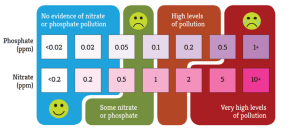- Electrical Conductivity (EC): Conductivity is the ability of water to conduct electricity, which depends on the impurities in the water and is affected by temperature. Electricity is conducted by the available ions, or electrolytes, dissolved in the water, an increase or decrease, can indicate pollutants, affecting the quality of the water. A sewage leak increases the EC because of additional ions such as chloride, phosphate, and nitrate.
-
Nitrates: High levels of nitrate in water can be a result of runoff or leakage from fertilized soil, wastewater / sewage, landfills, septic systems, or urban drainage. In river water it often ranges from 0.01-3.0 mg/L (ppm).
-
Phosphate: Excessive phosphorus in surface water can cause explosive growth of aquatic plants and algae. This leads to a variety of water-quality problems, including low dissolved oxygen concentrations, which can cause fish to die & harm other aquatic life. It is a good measure of sewage pollution.
Taking immediate action if necessary, if you see any of the following:
• Pollution to water or land
• Damage or danger to the natural environment,
• Dead fish or fish gasping for air
• Collapsed or badly damaged riverbank
Environment Agency 24-hour Incident Hotline 0800 80 70 60
Total Data
Seasonal Data
Autumn 2023 (1st Sept – 30th Nov)
Winter 2023/24 (1st Dec – 29th Feb)

